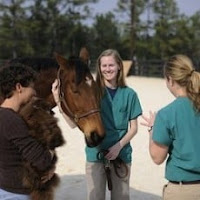You’ve found him – the horse of your dreams. He looks like he stepped from a breeder’s catalogue and he moves like an Olympian athlete. He’s in your price range. He’s even a nice guy. He saved a child from a falling down a well this one time. When you go to get on him he kneels down on one front leg to make it easier for you to mount. You fall in love. And then, you look at the feet….
There’s no such thing as a perfect horse, says every person who’s managed to suppress the five year old child deep inside them that believes that every pony is a unicorn. Whatever horse you decide on, you’re going to have some maintenance to do. That said, not all maintenance is equal. Pretty big difference between needing the occasional massage and needing stem cell therapy to mend a bowed tendon.
So what should your potential new horse’s feet look like? This is where knowing your conformation will come in handy:
- You’re looking for feet that are basically the same size, shape and angle when compared left to right. Small differences are normal, but each pair should look like they come from the same horse.
- Feet (and the rest of the leg they’re attached to) should point straight ahead. Back feet should point out a bit, but the leg should also turn out at the same relative angle.
- Feet should be proportionate in size and shape to the rest of the horse.
- The hoof surface should be smooth and even without major cracks.
- The heels should be fleshed out, not contracted.
- Their pasterns should be free of scars that indicate that the horse interferes when it moves.
You’ll know to walk away if your prospective new partner’s feet seem to be held together with reconstructive putty and duct tape (or you should know. If you’re not clear about this, you should have somebody going with you as you look…). But not everything is so black and white. Let’s go through some common hoof problems you might run across and some of the risks and maintenance that might come with them.
Club Feet
A club foot is more upright than a normal foot and usually comes with a dished appearance. This can be a problem because the soft tissue around the coffin joint is less flexible and the coffin bone easier to injure. The extent to which this is a problem will depend on how severe the deformity is and what other conformation problems come with the club foot (horses that have club feet are often also back at the knee, which compounds the issues). At the very least, you’ll be needing a good farrier to keep the heels low and protect the toes from excessive wear. Lots of club-footed animals have long and successful careers, but it is something you should talk to your vet about prior to making a decision.
Toeing in or Toeing Out
These conformation faults are genetic and often accompanied with angular limb deformities. Toeing in or out is an issue because when the horse travels, he won’t travel straight. He’ll put uneven stress on his feet and legs, which can lead to problems like injuries from interfering and soft tissue pulls and strains, especially over time. Like everything, the severity of the problem will depend on how severe the feet deviate from the norm. Protective boots and careful corrective shoeing and/or trimming that takes the health of the whole leg into consideration is going to be key.
Laminitis
It’s not always possible to tell if a horse has had laminitis in the past. If a horse has foundered, there will be some classic signs (prominent rings around the hoof wall, a wider white line, lowered heels, dished hoof walls), but if the laminitis is mild, you might have to rely on owner disclosure. Laminitis is treatable, but horses who have had it are at much higher risk of having it again. Aside from needing a regular and knowledgeable farrier, you’ll also have pasture access, weight gain and stress to manage.
Navicular
To tell if a horse has navicular, you’ll either need to be told that the horse has navicular or you’ll need to have some x-rays taken. Changes in the navicular bone are sometimes minor and stable, but they can and often do get worse over time and lead to persistent lameness. To manage navicular you’ll need a quality farrier (you’ll be noticing a theme here…) and potentially a range of other treatments from pain control to cutting edge medicine to keep the bone from degenerating.
Corrective Shoes
If the horse is wearing corrective shoes and/or pads, you need to know what’s being corrected and why. A seller should be willing to answer questions and let you talk to the horse’s regular farrier so you know what’s going on. There are a lot of minor issues that could be major ones if the problems a horse has don’t suit the job you want the horse to do. Thin soles aren’t so much a problem for a dressage horse, but if you’re a competitive trail rider, you might want to keep looking.
Remember, too, that pretty is as pretty does. Some horses can have really messed up looking legs and be sound as bells for their whole lives. Your best bet is always to ask questions of the seller, get information from the horse’s usual farrier and vet, and have a vet and a farrier of your own to ask questions of. A good pre-purchase vet exam can save you a lot of time, money and heartbreak. Sleuthing is way better to do before instead of after, when all of the horse’s issues will become yours.
By Cindy McMann
image 1: pxhere; image 2: AuburnAlumniAssociation (Creative Commons BY)









